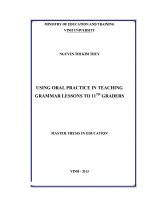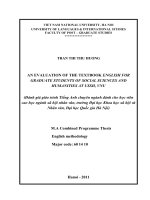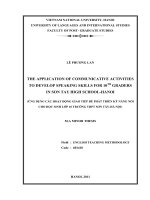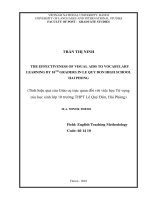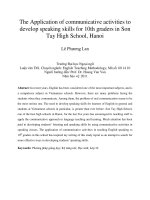Warm – up activities in teaching and learning English at grade 10A5 in Cai Be high schoo
Bạn đang xem bản rút gọn của tài liệu. Xem và tải ngay bản đầy đủ của tài liệu tại đây (191.56 KB, 35 trang )
ACKNOWLEDGMENTS
First, I would like to express sincere thanks to the Management Board of Dong Thap
University for giving me chance to study the study of educational reality.
I would like to send my special thanks to PhD Do Minh Hung (who is the Head) and
the lecturers of the Foreign Language Department at Dong Thap University for their help and
encouragement during my study.
I would like to express my deep gratitude to Ms. Le Hong Phuong Thao, MA, my
supervisor, for her precious advice, insightful comments as well as her considerate assistance
and adequate supervision.
I would also acknowledge my great thankfulness to all my lecturers at Dong Thap
University, Ms. Nguyen Thi Thuy Hang and Mr. Nguyen Anh Nhan, my trainers and my
students at grade 10A5 in Cai Be high school, and also send to my boundless gratefulness to
MA Huynh Ngoc Diep, the Head of Cai Be high school, all of teachers and students at Cai Be
high school for their help, encouragement and invaluable support, without which I would have
never been able to complete the study of educational reality.
Finally, I must express my special gratitude to my beloved family, my closed friends
and my classmates, who have given me their best regards, helpful advice as well as precious
supports during my study.
i
TABLE OF CONTENT
Page
ACKNOWLEDGMENTS............................................................................................................i
TABLE OF CONTENT..............................................................................................................ii
Part I. INTRODUCTION............................................................................................................1
1. Motivation for the study:.................................................................................................1
2. Aim of the research:........................................................................................................1
3. The research question:.....................................................................................................1
4. The research method:......................................................................................................1
5. Significance of the research:...........................................................................................2
6. Scope of the research:......................................................................................................2
7. Organization of the study................................................................................................2
Part II. THE CONTENT..............................................................................................................4
Chapter One. BACKGROUND INFORMATION..................................................................4
I. 1. Cai Be high school.......................................................................................................4
I. 2. Teachers staff:..............................................................................................................4
I. 3. Students: ......................................................................................................................4
I. 4. Warm-up activities.......................................................................................................6
I. 4. 1. Definition of warm-up activities..............................................................................6
I. 4. 2. The value of warm-up activities...............................................................................7
I. 4. 3. Why do we use warm-up activity?...........................................................................8
Chapter Two. METHODOLOGY...............................................................................................9
II. 1. Research question...........................................................................................................9
II. 2. The researcher.................................................................................................................9
II. 3. The setting......................................................................................................................9
II. 4. The subjects....................................................................................................................9
II.5. Data collection instrument...............................................................................................9
II. 5. 1. Questionnaires......................................................................................................10
II. 5. 2. Observation...........................................................................................................11
II. 6. Data collection procedure.............................................................................................11
II. 6. 1. Questionnaires......................................................................................................11
II. 6. 2. Observation...........................................................................................................12
Chapter Three. Result and Discussion.......................................................................................13
III. 1. Result of interview......................................................................................................13
III. 1. 1. Students...............................................................................................................13
III. 1. 2. English teachers...................................................................................................16
III. 2. Result of observation...................................................................................................19
III. 3. Summary.....................................................................................................................19
Chapter Four. Recommendation and Conclusion......................................................................20
IV.1. Conclusions .................................................................................................................20
IV. 2. Recommendation ........................................................................................................21
ii
IV. 1. 1. For English teachers............................................................................................21
IV. 1. 2. For students.........................................................................................................21
IV. 1. 3. For union local....................................................................................................21
IV. 3. Limitations..................................................................................................................21
REFERENCES..........................................................................................................................23
APPENDIX 1............................................................................................................................24
APPENDIX 2............................................................................................................................25
APPENDIX 3............................................................................................................................26
iii
Part I. INTRODUCTION
1. Motivation for the study:
Up to now, English which is used very popular in Vietnam is an important international
language. English is one of the important subjects at High School. It has been used for Final
Examinations to evaluate students’ level of knowledge. Therefore, whether students are
proficient at English or not is very important to them. Being proficient at English means
student is good at both received skills - reading and listening, and productive skills - speaking
and writing. These four skills are integrated in a lesson to improve all these skills for the
students, because one certain skill can be used to improve the others. But it is very hard for
people to begin learning English. Therefore, it is necessary to have teaching and learning
English methods and techniques. To make students interested is very important for teachers,
especially English teachers. How must we do that? This is the responsibility of all of the
teachers! Warm – up activities are a way in which we can take interest, but how do English
teachers in high schools apply these activities? There are many ways to make good warm – up
activities at high schools. This is a reason why I choose “warm – up activities in teaching and
learning English at grade 10A5 in Cai Be high school” to research. According to this research,
I myself will get experiences to improve skills and teaching methods.
2. Aim of the research:
To make students interested in learning English at high schools.
3. The research question:
What are problems in warm – up activities which teachers give for students?
4. The research method:
Interview method
Observation method
1
5. Significance of the research:
To make good warm – up activities.
6. Scope of the research:
Warm – up activities in grade 10A5 at Cai Be high school.
7. Organization of the study
Acknowledgment
Table of contents
Part I. Introduction
1. Motivation for the study
2. Aim of the research
3. The research question
4. The research method
5. Significance of the research
6. Scope of the research
7. Organization of the study
Part II. The content
Chapter One. Background Information
I. 1. Cai Be high school
I. 2. Teachers staff
I. 3. Students
I. 4. Warm-up activities
I. 4. 1. Definition of warm-up activities
I. 4. 2. The value of warm-up activities
I. 4. 3. Why do we use warm-up activity?
Chapter Two. Methodology
II. 1. Research question
II. 2. The researcher
II. 3. The setting
2
II. 4. The subjects
II. 5. Data collection instrument
II. 5. 1. Questionnaires
II. 5. 2. Observation
II. 6. Data collection procedure
II. 6. 1. Questionnaires
II. 6. 2. Observation
Chapter Three. Result and Discussion
III. 1. Result of interview
III. 1.1. Students
III. 1. 2. English teachers
III. 2. Result of observation
III. 3. Summary
Chapter Four. Recommendation and Conclusion
IV. 1. Conclusion
IV. 2. Recommendation
IV. 2. 1. With English teachers
IV. 2. 2. With students
IV. 2. 3. With union local
IV. 3. Limitations
References
Appendices
3
Part II. THE CONTENT
Chapter One. BACKGROUND INFORMATION
I. 1. Cai Be high school
Cai Be high school was built in 1960s. At present, school has 21 learning rooms, a
library, three laboratory rooms for three subjects (physics, chemistry, and biology), three
computer rooms (40 computers and one host computer) for teaching and learning information
technology. And there are also many rooms such as a headmasters’ room, two vice-principal’
rooms, one finance room, one teachers’ room, one health care room for school, and etc.
Especially, all of learning rooms has computer to apply electronic lesson plan to teach.
Besides, school also has sports ground, gymnastics ground for students to play sport and learn
gymnastics. There are many benches and trees in a school yard where students can relax and
revise students’ lesson. At the present, Cai Be high school also lacks loudspeakers. There are
only five loudspeakers, six phonographs to provide for teaching and learning English.
Cai Be high school is school at the three zones, Cai Be town, Cai Be district, Tien
Giang province. It is one of four high schools in Cai Be district.
I. 2. Teachers staff:
At the moment, there are 85 teachers including 39 female teachers and 46 male
teachers. All of teachers have a bachelor’s degree.
In English departments, there are 6 teachers. One of them is male.
I. 3. Students:
In this school year, Cai Be high school has 14 classes in grade 10, 13 classes in grade
11 and 14 classes in grade 12. The number of students at Cai Be high school belongs to
register of overseer, such as:
4
Total students Boys Girls
Class 10 603 216 387
Class 11 571 237 334
Class 12 607 187 420
All of school 1781 640 1141
Grade 10A5 43 15 28
Figure 1. Figures of students at Cai Be high school
In the first term, about learning capacity and conduct of student at grade 10A5 as
follow from mark-book of senior master:
Learning capacity Good Moderated good Average Weak Bad
Quantity 3 13 20 6 1
Figure 2. Figures learning capacity of students at grade 10A5
Conduct Good Moderated good Average Weak Bad
Quantity 33 9 1 0 0
Figure 3. Figures conduct of students at grade 10A5
In English, points of students at grade 10A5 following:
Point 8.0 – 10.0 6.5 – 7.9 5.0 – 6.4 4.0 – 4.9 < 4.0
5
Quantity 3 8 11 13 8
Figure 4. Figures point of students about English at grade 10A5
I. 4. Warm-up activities
I. 4. 1. Definition of warm-up activities
When preparing your lesson, you star by planning the main items you want to include:
the teaching of a new grammar point, or a grammar exercise, or the reading of a text. But once
you have prepared the main components of your lesson, and made sure it is learning-rich,
varied and interesting, you may find you still need some extra ingredients to make it into a
smooth, integrated unit. You may need, for example:
- A quick warm-up for the beginning to get your students into the right mood for
learning;
- An idea for a brief vocabulary review before starting a new text;
- A light filler to provide relief after a period of intense effort and concentration;
- A brief orientation activity to prepare a change of mood or topic;
- A game or amusing item to round off the lesson with a smile.
Besides contributing to routine lesson planning, you may find these activities can be of
use in non-routine situations as well: when, for example, you have to fill in for another teacher
and need some quick, easily-prepared ideas for instant use; or for supplying extra content for
an English club evening or English party; for helping a group of new students to get to know
one another; or for keeping students profitably busy when you unexpectedly have extra time
on your hands.
Therefore, to begin the new lesson, we often have warm-up activity, or five-minute
activity, or playing game. What is a warm-up activity? It means an activity which is
entertaining and engaging, often challenging and an activity in which the learners play and
usually interact with other.
6
I. 4. 2. The value of warm-up activities
Through warm-up activities, learners practice and internalize vocabulary, grammar and
structures. Motivation is enhanced, to, by the warm-up activity and the competition. And
added benefit is that the learners’ attention is on the message, not on the language. They
acquire language unconsciously, with their whole attention engaged by the activity in much
the same way as they acquired their mother tongue.
"Activities of a socially infectious nature, where stress is placed on cooperative, rather
than the competitive, aspects of some recreation activities, can be used to attract patients'
attention and to sustain their interaction. Very simple games played in a small group may
serve to encourage participation by making the patient feel an integral and necessary part of
the activity." (O'Morrow, The Whys of Recreation Activities for Psychiatric Patients,
Therapeutic Recreation Journal, 3rd quarter, 1971).
Warm-ups help your learners put aside their daily distractions and focus on English. If
they haven't used English all day, they may take a little while to shift into it. Warm-ups also
encourage whole-group participation which can build a sense of community within the group.
For new groups, see the list of ice breakers further down.
"Activities.... help them (individuals with mental & emotional illness) reestablish
constructive self-attitudes and restore self-confidence and a sense of security." (O'Morrow,
The Whys of Recreation Activities for Psychiatric Patients, Therapeutic Recreation Journal,
3rd quarter, 1971).
There are many advantages of using warm-up activities in the classroom:
1. Warm-up activities are a welcome break from the usual routine of the language class.
2. They are motivating and challenging.
3. Learning a language requires a great deal of effort. Warm-up activities help students to
make and sustain the effort of learning.
4. Warm-up activities provide language practice in the various skills- speaking, writing,
listening and reading.
5. They encourage students to interact and communicate.
6. They create a meaningful context for language use.
7
I. 4. 3. Why do we use warm-up activity?
- Language learning is hard word.
One must make an effort to understand, to repeat accurately, to adapt and to use newly
understood language in conversation and in written composition. Effort is required at every
moment and must be maintained over a long period of time. Warm-up activity helps and
encourages many learners to sustain their interest and work.
- Experiencing language.
Warm-up activity also helps the teacher to create contexts in which the language is
useful and meaningful. The learners want take part, and in order to do so must understand
what others are saying or have written, and they must speak or write in other to express their
own point of view or give information. Warm-up activity provides one way of helping the
learners to experience language rather than merely study it.
- Repeated use of language items.
Many warm-up activities cause as much use of particular language items as more
conventional drill exercise; some warm-up activities do not. What mater, however, is the
quality of practice.
The contribution of drill exercise lies in the concentration on a language form and its
frequent occurrence during a limit period of time. Many warm-up activities similarly provide
repeated occurrence and use of a particular language form. By making language convey
information and opinion, warm-up activities provide the key features of “drill” with the added
opportunity to sense the working of language as living communication.
Warm-up activities involve the emotions, and the meaning of the language is thus more
vividly experienced. It is, for this reason, probably better absorbed than learning based on
mechanical drills.
- Central to learning.
If it is accepted that warm-up activities provide intense and meaningful practice of
language, then they must be regarded as central to a language teacher’s repertoire and not
merely a way of passing the time.
8
Chapter Two. METHODOLOGY
II. 1. Research question
What are problems in warm – up activities which teachers give for students?
II. 2. The researcher
The study is done by Do Van Hung, a student of class English 2006A, Foreign
Language Department, Dong Thap University.
II. 3. The setting
The study took place at Cai Be high school, where I practiced. It was done in
cooperation with the teachers and the students at Cai Be high school. The study was carried
out in the eighth term of my semesters. The aim is to find out what difficulties the teachers
encounter when planning warm – up activities.
II. 4. The subjects
The subjects of the study are:
Teachers in Cai Be high school.
Students in Cai Be high school.
Warm – up activities.
II.5. Data collection instrument
A number of produces have been used for collecting information such as interviews,
observations, record reviews, diaries, material analysis, etc. (Nunan, 1992). In this research,
two instruments: questionnaires and observation were chosen and employed. The usage of
these instruments will be discussed below.
9
II. 5. 1. Questionnaires
A questionnaire is defined as “an instrument for the collecting data, usually in written
form, consisting of open and/or closed questions and other probes requiring a response from
subjects” (Nunan, 1992, p.231).
Questionnaires are printed form for data collection, which includes questions or
statements to which the subjects are expected to respond, often anomalously. Many
researchers state that questionnaires are commonly used to collect data on phenomena, which
are not easily observed, such as attitudes, motivation and self-conceptions, in other words,
those in social science.
The present researcher’s choice of using questionnaires comes from the
following reasons. Firstly, questionnaires save the researcher’s time. They are self-
administered and can be given to large groups at the same time. It is easy to get the
information from many people quickly and without the need of the researcher’s presence.
Secondly, questionnaires help avoid pressure of interview bias when completing the
questionnaires. Furthermore, when anonymity is assured, respondents tend to feel free to what
they answer so that the result will be objective. It is because there is no face-to-face interaction
between subjects and the interviewer. Questionnaires in the form of closed questions or
statements, in which the respondent is asked to select an answer from a list provided by the
researcher, provide a great uniformity and standard of responses are easy for statistical
analysis afterwards.
In order to answer the research questions, the two questionnaires were applied:
Questionnaires 1 (See Appendix 1) were given to the students to know their attitude
about warm-up activities and their ideas about warm-up activities. The questionnaires included
10 items.
Questionnaires 2 (See Appendix 2) were given to the teachers to know the shape of the
warm-up activities they use in high school. How do they plan the warm-up activities in
teaching periods? The questionnaires consisted of 10 items.
10
II. 5. 2. Observation
Wajnryb (1992, p.1) said that observation is multi-faceted tool for learning. The
experience of observing comprises more than the time actually spent in the classroom. It also
includes preparation for the period in the classroom and follow-up from the time spent there,
the preparation can include the selection of a focus and the method of data collection. In this
study, observation is to know the real situation of the warm-up activities, and compare the
reality with the result of questionnaires 1 and questionnaires 2.
Basic standard for teaching period (See Appendix 3)
1. To begin the new lesson, teacher must make warm-up activities.
2. Teacher should often change many forms of warm-up activities.
3. Teacher has to control times of teaching period, all of students in grade.
4. Student is confident, active, self-motivated and self-conscious when taking part in warm-up
activities.
5. Warm-up activities must be various and is used to revise old knowledge and to lead to the
new lesson.
6. Warm – up activities must be suitable with ability of students.
II. 6. Data collection procedure
This sub-section describes the steps that were taken to carry out the results of the study.
II. 6. 1. Questionnaires
+ For students
There were 43 questionnaires 1 delivered to grade 10A5, after giving the questionnaires
and guiding students to do in ten minutes, the questionnaires were collected back. They were
done in the ninth week, from 15
th
March to 20
th
March.
+ For English teachers
In the ninth week, from 15
th
March to 20
th
March, questionnaires 2 were given to six
English teachers of the school at the beginning of the week, and they were collected at
weekend.
11



